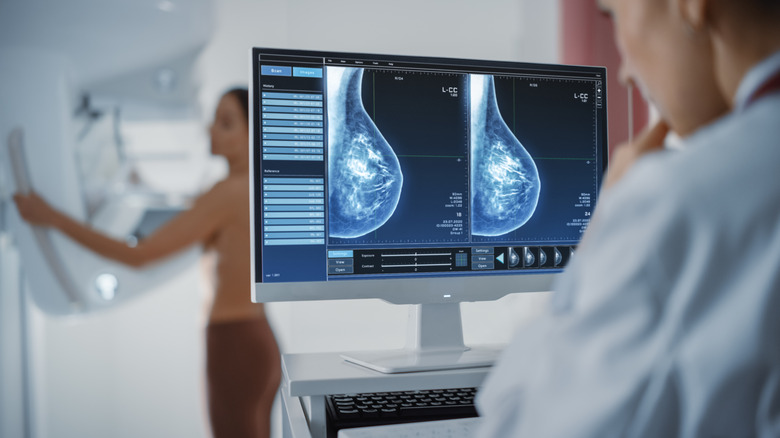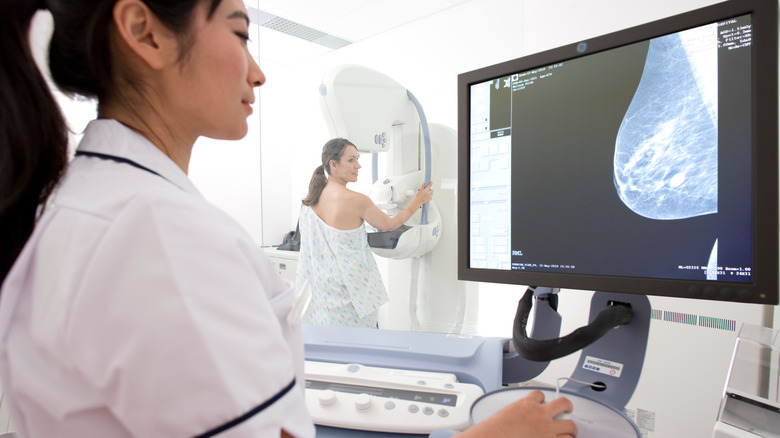Dense Breasts Are Burdensome To Women, Including Out-Of-Pocket Costs & Increased Risks
If you've ever had a mammogram, you may have been informed by your technician or healthcare provider that you have dense breasts or dense breast tissue. However, you may still have dense tissue even if you weren't informed of your breast tissue's viscosity status. Until now, there was no federal requirement for healthcare providers to offer women this information. While certain states have opted to notify women with dense breasts for years, every state is now required to do so.
Why does the density of your breast tissue matter? According to Mayo Clinic, people with dense breasts are at a significantly higher risk of developing breast cancer. This increased risk, combined with other factors unique to dense breast tissue, can lead to healthcare providers taking an atypical approach to breast cancer screenings, the cost and obligation of which lands squarely on the shoulders of patients. Here's what you need to know.
The risks and costs of dense breasts
Having dense breasts, unfortunately, makes you more likely to develop breast cancer throughout your lifetime. Researchers have not yet determined exactly why this is the case. Thankfully, dense breast tissue does not appear to affect the survival rate of breast cancer overall. However, it can make breast cancer more difficult to detect on a mammogram.
When a medical professional is examining a mammogram image, according to the American Cancer Society, dense breast tissue appears white. In contrast, fatty tissue shows up as a shade of dark gray. Since cancer also appears white on mammogram imagery, it can be tough to decipher cancerous tissue from dense tissue. In contrast, a breast with more fat than dense tissue will display cancer much more readily.
Due to the increased risk of cancer and the potential for misdiagnosis, many physicians will recommend that patients with dense breast tissue have more frequent mammograms or that they supplement mammograms with other imaging tests. Since each of these tests comes with a price tag of hundreds of dollars, identifying as someone with dense breast tissue can carry a significant financial burden. The cost of mammograms ranges from $600 to over $3,000, and you can expect to pay $60 to $170 for an X-ray. An ultrasound-guided breast biopsy can cost around $150 or as high as $700.
What exactly are dense breasts?
Breasts are made up of fatty, glandular, and fibrous tissues. Glandular tissue includes all tissues essential to milk production: the lobes, where breast milk is stored, and the ducts, through which it travels to the nipple. This glandular tissue is supported by fibrous tissue that keeps it securely where it belongs for optimal milk production. Together, the network of glandular and fibrous tissue is called fibroglandular tissue. The remaining space in the breasts is filled by fatty tissue, which provides the majority of their shape and volume, via the Centers for Disease Control and Prevention (CDC).
Approximately 10% of women have breasts made up almost entirely of fatty tissue, and another 10% have breasts made up almost entirely of fibroglandular tissue. About 40% of women have breasts made up of primarily fatty tissue with areas of fibroglandular tissue, while the other 40% have breasts that feature an even distribution of fibroglandular tissue. Those whose breasts are almost entirely made up of fibroglandular tissue or feature an even distribution of fibroglandular tissue are considered to have dense breasts.
How to identify dense breast tissue
All adult women should perform self-examinations of their breasts on a consistent monthly basis. Examining your breasts both visually and manually on a regular schedule increases the likelihood that breast cancer — should it develop — will be detected at a very early stage. When cancer is detected early, less aggressive treatment options can become more viable.
While self-exams are an invaluable tool for detecting breast cancer, unfortunately, they cannot reveal the density status of your breasts. The only way to determine whether you have dense breast tissue is to have your breasts temporarily flattened and x-rayed via a mammogram. There is no reliable method to tell whether breasts contain dense tissue or not that utilizes a simple visual or physical examination. Once you've had a mammogram, if your breasts are identified as dense, you can also determine whether your tissue is highly viscous.
Risk factors for dense breasts
While it isn't possible to identify dense breasts simply by looking at or touching them, certain characteristics are associated with dense breast tissue. The primary determining factor of whether or not you have dense breasts is genetic predisposition. If your mother has been informed that she has dense breast tissue, you may want to speak to your doctor about when to begin screening tests.
In addition to genetics, several risk factors for dense breast tissue have been identified. These include having a low body weight in relation to your height and taking hormone replacement therapy medications. This is particularly true in cases of estrogen replacement therapy in women who have entered natural or surgically induced menopause. It is important to note that none of these risk factors guarantee that you have or will develop dense breast tissue. The only way to determine your breast density is by undergoing imaging ordered by a medical professional.
When to consider additional screenings
Having dense breast tissue does not necessarily mean that you need to (or will in the future) have more frequent mammograms or that you'll require additional screening for breast cancer. What does mean is that you'll need to be mindful of your increased level of risk and be sure to keep up with the routine mammogram schedule that your doctor suggests, which will take into consideration other factors like family and health history.
If your mother or other women in your family have had breast cancer, you've undergone testing for genetic mutations, and you have dense breast tissue, your doctor may suggest a more aggressive screening protocol. This could include alternating mammograms with MRI scans every six months. The best prevention plan is always the one that you carefully craft with your trusted medical care provider, who knows both your personal and family medical history.





